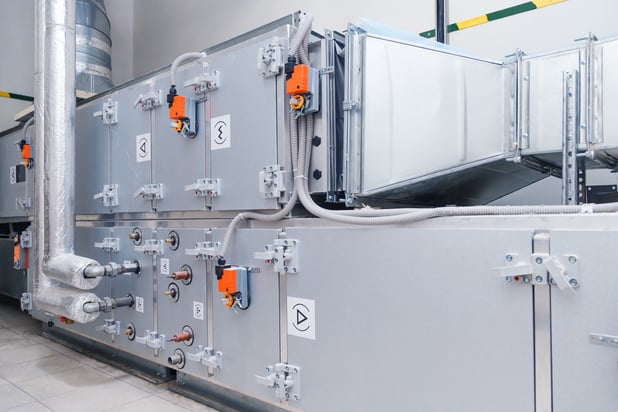 HVAC systems are a big deal when it comes to energy efficiency and conservation, but will a new or existing HVAC system play nicely with your Building Automation System (BAS)?
HVAC systems are a big deal when it comes to energy efficiency and conservation, but will a new or existing HVAC system play nicely with your Building Automation System (BAS)?
It depends a lot on the age and integration readiness of your HVAC, your BAS, and your building, and the specific needs of your tenants or occupants. Much of it also boils down to choosing a knowledgeable, experienced provider with the necessary skills.
Below, we discuss the critical factors and key steps that guide the integration of an HVAC with your BAS and the enhanced control capabilities this will allow you to unlock. We’ll also consider the wider benefits, like better efficiency and control, for you and your management team.
How to Integrate HVAC into Building Automation
Your facility’s building automation system is designed to do a lot. Most BASs these days are capable of fine-tuned control of your lighting, security, and fire suppression systems.
However, you signed on the line for a comprehensive building automation solution because you were told you would save big on energy bills. And taking control of energy bills in any large facility means taking control of your HVAC system.
Your heating, cooling, and air conditioning (HVAC) systems are the core of your energy efficiency plan. In fact, The Department of Energy estimates that HVAC equipment accounts for 44% of energy use in commercial buildings.
That means making sure out-of-the-box or installed HVAC hardware connects with and talks to your brand-new or upgraded BAS is pretty much mission-critical.
First up, let’s take a closer look at some key factors or decisions that go into a successful HVAC-BAS integration.
Plugging In: HVAC-BAS Decision Factors
Ideally, you’d roll out brand-new HVAC and BAS systems at the same time, matching equipment from both systems perfectly with your site specifics and unique business requirements.
If only life worked like that. Here are four key decision factors that will define the HVAC-BAS implementation you end up carrying out.
1. Your Company’s Needs
Let’s be real: HVAC control and automation are a huge part of your BAS’s reason for existing. In a perfect world, you’d install an all-new optimized BAS with every new HVAC installation. Unfortunately, unless you’re lucky (or rich) enough to be able to build from scratch, you’re more likely to be dealing with some sort of legacy implementation.
Here in the real world, both systems are probably rolled out piecemeal. You’re more likely to be piggybacking upgraded energy-efficient HVAC devices with an existing (legacy) BAS infrastructure, or even connecting parallel existing HVAC and building management systems to achieve higher levels of automation.
You might not make the decisions but you need to deliver them, so it pays to work with a flexible equipment provider and integration contractor like Mid-Atlantic Controls (MACC). As experts in both greenfield and legacy HVAC-BAS integration, we can help you unlock the benefits of cutting-edge equipment while still getting the best out of your existing BAS infrastructure.
2. Your Front-End Network Controller
Your front-end network controller connects the supervisory interface of your BAS with all HVAC systems including field-level devices like sensors, heaters, and handlers. Why is it important? Your controller is the platform that supports your entire integration project, so it’s a smart place to invest money by choosing a quality, trusted product.
Our engineers like the Tridium/Vykon controller. It’s tough and flexible, and its open-source DNA means it can be connected with the right drivers to talk with your building’s existing equipment as well as your human-facing supervisory and analytical systems.
3. Your HVAC System
What kind of HVAC are you integrating with your BAS? Commercial systems can range from a simple air pump or furnace setup to huge installations serving thousands of feet and power, balanced by a complex system of pumps and handlers.
From a technical point of view, the type and age of your system is more important than its size. You’re going to need experienced help, even on a relatively small and simple job, and from a provider with the technical chops to manage mechanical, electrical, and IT systems integration.
At MACC, we’re happy working with the latest open-source BACnet SC protocols and plug-and-play IP devices, but we’re also recognized experts at integrating next-generation BAS functionality with legacy HVAC systems. That can mean digging up licensing older proprietary drivers and expanding the licensing for a secure connection to your new BAS front end.
4. Your Building
Technical fixes aside, the size of your building and what it is used for do matter — a lot. Your integration project will scale directly with floor space served because any single pump, blower, or handler will only be able to serve a set number of square feet.
The complexity of your system can also add material and labor costs because the number of integration challenges that need to be solved will increase, even if the individual fix is technically quite straightforward.
You’ll need the help of an industrial controls specialist like MACC for at-scale projects, and especially if your facility includes chilled water plants, hot water systems, or specialist air handling or explosion-prevention systems.
For small buildings or single-unit installations, it can be tempting to ask your HVAC equipment supplier to do the integration or even attempt it yourself. Remember that your BAS is a complex, balanced system that delivers efficiencies at scale. Settling for a good enough integration or treating your HVAC-BAS system as piecemeal could end up robbing you of significant savings.
Key Steps for Integrating HVAC with BAS
What does a typical integration rollout look like from conception to commissioning? Most implementations involve five distinct phases:
|
1. Assessment and Planning |
|---|
|
|
2. Choose the Right Technology and Partner |
|
|
3. Installation and Configuration |
|
|
4. Testing and Optimization |
|
|
5. Ongoing Support |
|
Why Choose BAS Control?
Is BAS control of your HVAC systems really worth it? After all, most off-the-shelf HVAC systems come with pretty adequate control of their own, especially if you are ventilating a standard office or consumer space with no special requirements.
This “just good enough” approach doesn’t hold up against rising energy costs and increased concerns about carbon emissions — especially for power-hungry HVAC equipment.
While HVAC devices like heat pumps and gas and electrical furnaces are becoming more efficient, only smart monitoring and control of these systems across your entire facility will turn efficiency gains into measurable bottom-line results.
Smart building automation allows you to optimize HVAC system performance across your facility. You’ll get more out of your existing devices and maximize investment in newer, high-efficiency heating and cooling equipment.
Today, modern open-source protocols like BACnet are laying the groundwork for a future where devices will connect more easily, and share information in more ways than ever before. Meanwhile, the AI revolution is opening up new possibilities for data analytics, allowing us to use this information to predict, optimize, and reduce our energy use.
That’s why the real question is not whether you should choose BAS control for your building’s HVAC systems, but whether you can afford not to.
MACC: Your HVAC-BAS Installation Partner
MACC is an independent control systems contractor specializing in commercial and industrial building automation systems.
From schools to hospitals, data centers to office parks, we’ve helped building and facility managers across many industries achieve real efficiencies and measurable savings while keeping occupants, owners, and investors happy.
We’re experts at the open-source IP-driven sensors, controllers, and drivers that are unlocking the next wave of smart building automation. We’re also great at helping businesses future-proof their facilities while continuing to use the older-generation control equipment they have already invested in.
A full-service consultant for large and small projects, MACC provides assistance from project planning to sign-off, and we offer a range of service and maintenance services to support your systems long into the future.
Considering an HVAC upgrade for your facility or looking to get more out of your existing control and automation equipment? Give us a call to schedule a free consultation today.














